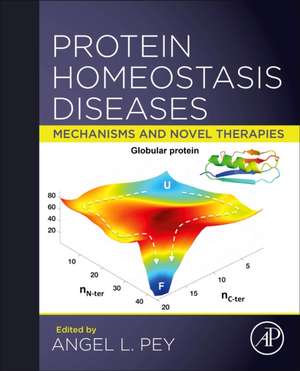Protein Homeostasis Diseases: Mechanisms and Novel Therapies
Editat de Angel L. Peyen Limba Engleză Paperback – 19 feb 2020
- Provides an interdisciplinary examination of protein homeostasis disorders, with an emphasis on treatment strategies employing small natural and pharmacological ligands
- Offers applied approaches in employing high throughput sequencing and screening to develop pharmacological chaperones to treat protein homeostasis disease
- Gathers expertise from a range of international chapter authors who work across various biological methods and disease specific disciplines of relevance
Preț: 917.99 lei
Preț vechi: 1008.79 lei
-9% Nou
Puncte Express: 1377
Preț estimativ în valută:
175.65€ • 183.89$ • 145.34£
175.65€ • 183.89$ • 145.34£
Carte tipărită la comandă
Livrare economică 31 martie-14 aprilie
Preluare comenzi: 021 569.72.76
Specificații
ISBN-13: 9780128191323
ISBN-10: 0128191325
Pagini: 450
Ilustrații: 60 illustrations (20 in full color)
Dimensiuni: 191 x 235 mm
Greutate: 0.89 kg
Editura: ELSEVIER SCIENCE
ISBN-10: 0128191325
Pagini: 450
Ilustrații: 60 illustrations (20 in full color)
Dimensiuni: 191 x 235 mm
Greutate: 0.89 kg
Editura: ELSEVIER SCIENCE
Public țintă
Active researchers and students in biochemistry, molecular biology, pharmaceutical science, cellular biology, organismal biology, and biotechnology; medical and physical chemists; clinician scientistsCuprins
I. Introduction of protein folding and homeostasis
1. Protein folding: how, why, and beyond
2. Protein homeostasis and disease
II. Protein folding and homeostasis at the organismal and proteomic scales
3. Caenorhabditis elegans as a model organism for protein homeostasis diseases
4. Proteome-scale studies of protein stability
5. Classifying disease-associated variants using measures of protein activity and stability
III. Protein homeostasis disturbance in disease: Genetics, mechanisms, and modulation by natural ligands
6. Protein destabilization and degradation as a mechanism for hereditary disease
7. Detection of amyloid aggregation in living systems
8. Molecular mechanisms of amyloid aggregation in human proteinopathies
9. Metals and amyloid gain-of-toxic mechanisms in neurodegenerative diseases
10. Vitamin B6-dependent enzymes and disease
11. Galactosemia: opportunities for novel therapies
12. Protein homeostasis and regulation of intracellular trafficking of G protein-coupled receptors
13. Structure-guided discovery of pharmacological chaperones targeting protein conformational and misfolding diseases
14. Virtual screening in drug discovery: a precious tool for a still-demanding
challenge
15. Differential scanning fluorimetry in the screening and validation of pharmacological chaperones for soluble and membrane proteins
16. Cellular high-throughput screening
17. High-throughput screening for intrinsically disordered proteins by using biophysical methods
18. Natural and pharmacological chaperones against accelerated protein degradation: uroporphyrinogen III synthase and congenital erythropoietic porphyria
1. Protein folding: how, why, and beyond
2. Protein homeostasis and disease
II. Protein folding and homeostasis at the organismal and proteomic scales
3. Caenorhabditis elegans as a model organism for protein homeostasis diseases
4. Proteome-scale studies of protein stability
5. Classifying disease-associated variants using measures of protein activity and stability
III. Protein homeostasis disturbance in disease: Genetics, mechanisms, and modulation by natural ligands
6. Protein destabilization and degradation as a mechanism for hereditary disease
7. Detection of amyloid aggregation in living systems
8. Molecular mechanisms of amyloid aggregation in human proteinopathies
9. Metals and amyloid gain-of-toxic mechanisms in neurodegenerative diseases
10. Vitamin B6-dependent enzymes and disease
11. Galactosemia: opportunities for novel therapies
12. Protein homeostasis and regulation of intracellular trafficking of G protein-coupled receptors
13. Structure-guided discovery of pharmacological chaperones targeting protein conformational and misfolding diseases
14. Virtual screening in drug discovery: a precious tool for a still-demanding
challenge
15. Differential scanning fluorimetry in the screening and validation of pharmacological chaperones for soluble and membrane proteins
16. Cellular high-throughput screening
17. High-throughput screening for intrinsically disordered proteins by using biophysical methods
18. Natural and pharmacological chaperones against accelerated protein degradation: uroporphyrinogen III synthase and congenital erythropoietic porphyria
